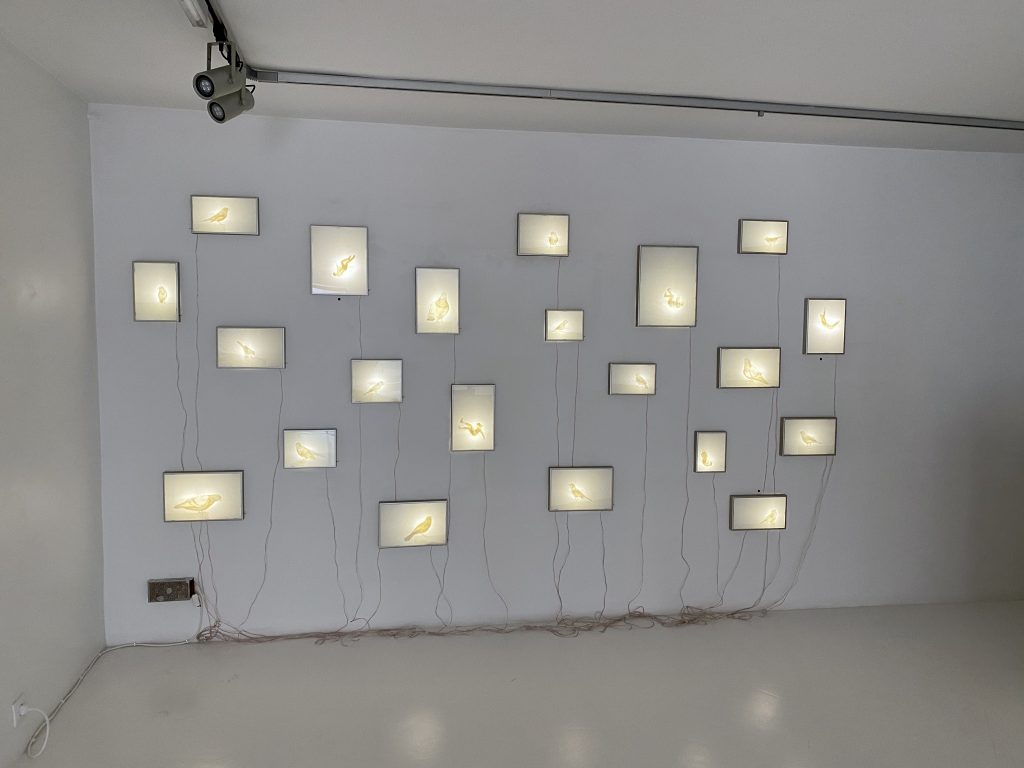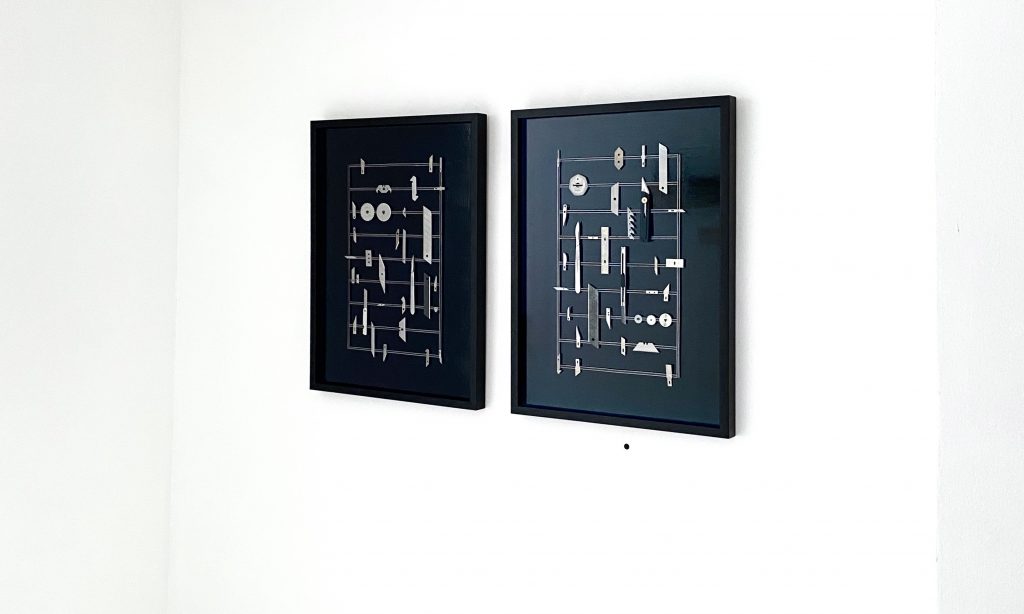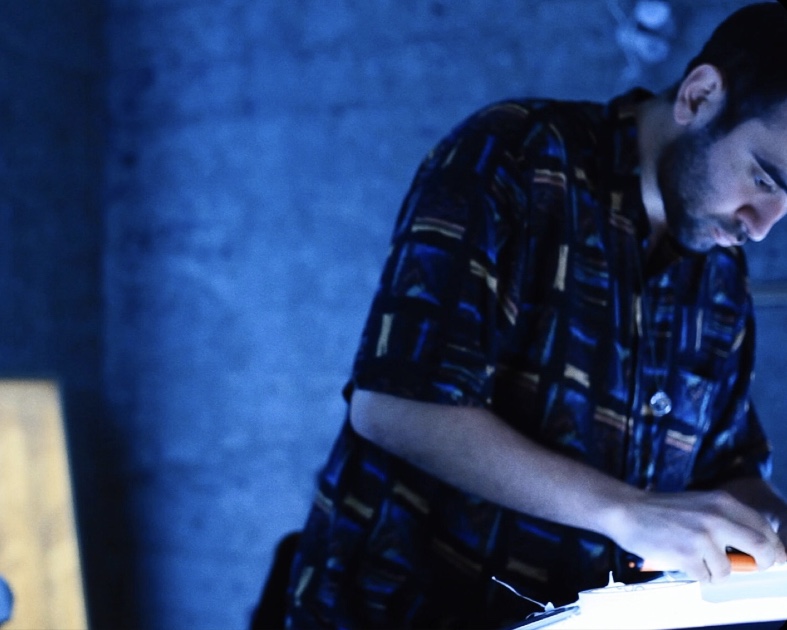The Chilean artist Carlos Rivera was born in 1985 in Bettembourg, Luxembourg. He Graduated in Fine Arts from ARCIS University (2011, Santiago, Chile). He currently lives and works in Santiago de Chile.
During his studies Carlos Rivera developed and experimented with a personal technique, based on the accumulation of layers of adhesive tape on backlit surfaces. This experimental technique was born from the desire to work on the imperceptible through the disappearance of the material that merges with the canvas, a darkness that is revealed as soon as the backlit surface lights up just like creating paintings that reveal the (in)visible.
What do you want to talk about in your work? Do you have a political approach?
In my works I want to talk about many things, but in the end I always prefer silence. A deep, dark and dangerous silence that translates into my artwork as a whisper. My work is silent but it is a noisy silence. Fascinated by the subtle border between the visible and the invisible, my artistic work is built in resonance with a personal investigation around the dialectic of shadow and light and its urban manifestation. My approach is centered around experimentation on the themes of absence, imperceptible, darkness and the exploration of the social memory of the places I inhabit.
I envision art and creation as a subtle and underlying guiding line to the tumults of life, as a powerful beat, a latent Leitmotiv that persists and impels a different way of interpreting the world; a sensitive and profound vision of perceiving everyday life and what surrounds me.
At present, my artistic research is more precisely focused on the social, violent, forgotten and invisible shadow cast by the light of power and domination, what I call the marginalization of darkness in large metropolises. I roam the streets of cities like a navigator without stars, a notebook in my hand to take notes, archive and collect the unnoticed traces of darkness, the debris and rubble that tell the violent memory of the places I pass through. I consider myself a craftsman of the invisible, a painter of absence, an urban archaeologist working meticulously to make visible and embody in a concrete way what light makes imperceptible.
What is the subject of the installation Visiblidad Suspendia? Is there a specific meaning to the birds and the bodies that appear to be falling which you are picturing in your recent work?
There are many possible interpretations of Visiblidad Suspendia, but the one that is the most important to me is how nature resists in big cities, how it keeps a trace in the public space and how finally we coexist together by creating bonds of closeness that on one hand seem so close but on another seem so far away. In this composition of urban fauna the roles are reversed, the birds are now spectators from the surface of humanity ‘flying’ and ‘jumping’ into the void.

« I consider myself a craftsman of the invisible, a painter of absence, an urbanarchaeologist working meticulously to make visible and to embody in a concrete way what light makes imperceptible. »
What brought you to work with adhesive tape?
I remember very early on I was obsessed with making paintings that could disappear. I was already fascinated by the world of the invisible. That’s how I started to carry out a series of experiments related to the invisibility of the artistic object. Among these experiments, I started to paint with adhesive tape. Based on these works, I have been developing, since 2010, a personal chiaroscuro technique based on the accumulation of layers of adhesive tape on backlit surfaces. This experimental technique is born from the will to work the imperceptible through the disappearance of the material that merges with the canvas, a darkness that is revealed as soon as the backlit surface lights up, thus creating paintings that reveal the (in)visible. This is how this technique was born and continues to develop. It is a technique in motion.
There is a certain melancholy in your work, a feeling of darkness but also a feeling of some hope throughout the light. Is this tension necessary for you? Do you need to immerse yourself in the negative, obscure things in society to find out light?
The search for darkness and its emotional response has always inspired my artistic research work. The marginalization of darkness is a rhetorical figure underlying all my work.
From light I am interested in its darkness and from darkness I am interested in its light. As a craftsman of darkness, as a painter of absence or as an urban archaeologist, I have developed a constantly evolving processor map built around the paradox of darkness of light. A semantic victory in which the lucidity of paradise alternates with its deepest night.
In your recent work we can see that the knife (the cutter), therefore your main tool to cut the ribbons, becomes the art work itself. What is that about?
The knife blade is the extension of my hand, a cold and violent tool that allows me to draw and paint with total determination. The knife is an integral part of my artistic production, as a technical tool but also as a creative and inspiring material. I like to conceive my artistic work as a whole concept, the tools often becoming artistic material. It’s all about perspective on how we perceive our environment.
In this sense, my artistic technique is mainly based on the recycling of precarious materials and the will to give another meaning to their basic use. Tape is then transformed into paint pigment, knife blades into glittering stars, and objects are transformed into objects of art.

Carlos Rivera ” ESPECTROS”
12 March – 14 May, 2020
Sobering Galerie
87, rue de Turenne
75003 Paris
+ 33 (0)9 66 82 04 43
contact@soberinggalerie.com

